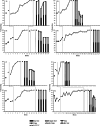Correspondence Between Vocal-Verbal Behavior and Go/No-Go Responses During the Successive Matching-to-Sample Procedure
- PMID: 38962521
- PMCID: PMC11217209
- DOI: 10.1007/s40616-024-00205-7
Correspondence Between Vocal-Verbal Behavior and Go/No-Go Responses During the Successive Matching-to-Sample Procedure
Abstract
In the current study, eight college students were exposed to a successive matching-to-sample (S-MTS) procedure utilizing non-verbal auditory stimuli consisting of common sounds. During emergent relations tests, participants were asked to talk aloud, and their vocal-verbal statements were transcribed and categorized as class-consistent, class-inconsistent, or irrelevant. All participants met emergence criterion for symmetry and four did so for transitivity/equivalence. Analysis of vocal-verbal statements showed a positive correlation between class-consistent statements emitted by participants and correct selection responses during S-MTS tasks. Such results suggest possible verbal mediation during emergent relations tests.
Keywords: Bidirectional naming; Equivalence; Mediation; Protocol analysis; Successive matching-to-sample.
© Association for Behavior Analysis International 2024. Springer Nature or its licensor (e.g. a society or other partner) holds exclusive rights to this article under a publishing agreement with the author(s) or other rightsholder(s); author self-archiving of the accepted manuscript version of this article is solely governed by the terms of such publishing agreement and applicable law.
Conflict of interest statement
Conflicts of InterestThe authors have no conflicts of interest.
Figures



Similar articles
-
Verbal Mediation During Auditory Equivalence Class Formation Using Go/No-Go Successive Matching-to-Sample.Anal Verbal Behav. 2024 Sep 30;41(1):11-25. doi: 10.1007/s40616-024-00209-3. eCollection 2025 Jun. Anal Verbal Behav. 2024. PMID: 40708966 Free PMC article.
-
The Use of the Go/No-Go Successive Matching-to-Sample Procedure with Nonverbal Auditory Stimuli to Establish Equivalence Classes and Speaker Behavior.Anal Verbal Behav. 2022 Feb 15;38(1):54-64. doi: 10.1007/s40616-022-00165-w. eCollection 2022 Jun. Anal Verbal Behav. 2022. PMID: 35719423 Free PMC article.
-
The establishment of auditory equivalence classes with a go/no-go successive matching-to-sample procedure.J Exp Anal Behav. 2021 Jul;116(1):44-63. doi: 10.1002/jeab.691. Epub 2021 May 6. J Exp Anal Behav. 2021. PMID: 33955545
-
The Problem of Class Breakdown in Sidman's (1994, 2000) Theory about the Origin of Stimulus Equivalence.Perspect Behav Sci. 2023 Feb 1;46(1):217-235. doi: 10.1007/s40614-023-00365-2. eCollection 2023 Mar. Perspect Behav Sci. 2023. PMID: 37006605 Free PMC article. Review.
-
An update on the search for symmetry in nonhumans.J Exp Anal Behav. 2021 Jan;115(1):309-325. doi: 10.1002/jeab.647. Epub 2020 Nov 22. J Exp Anal Behav. 2021. PMID: 33225440 Review.
Cited by
-
Verbal Mediation During Auditory Equivalence Class Formation Using Go/No-Go Successive Matching-to-Sample.Anal Verbal Behav. 2024 Sep 30;41(1):11-25. doi: 10.1007/s40616-024-00209-3. eCollection 2025 Jun. Anal Verbal Behav. 2024. PMID: 40708966 Free PMC article.
References
-
- Cabello F, Luciano C, Gomez I, Barnes-Holmes D. Human schedule performance, protocol analysis, and the “silent dog” methodology. The Psychological Record. 2004;54:405–422. doi: 10.1007/BF03395482. - DOI
-
- Chastain AN, Luoma SM, Love SE, Miguel CF. The role of class-consistent, and class-inconsistent intraverbal training on the establishment of stimulus classes. The Psychological Record. 2022;72(3):383–405. doi: 10.1007/s40732-021-00492-9. - DOI
LinkOut - more resources
Full Text Sources
Miscellaneous

